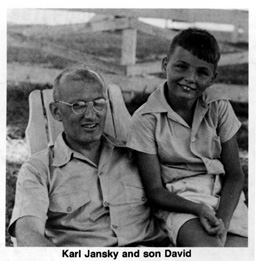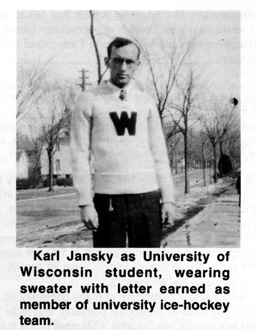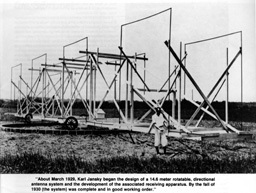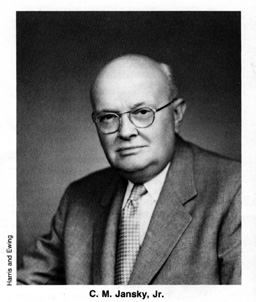 Karl Guthe Jansky was born on October 22, 1905, in what was then the Territory of Oklahoma where his father, Cyril M. Jansky, was Dean of the College of Engineering at the University of Oklahoma at Norman. Dean Jansky, born in Wisconsin of Czech immigrants, had started teaching at the age of sixteen. He was a teacher throughout his active life, retiring as Professor of Electrical Engineering at the University of Wisconsin. Karl Jansky's mother, nee Nellie Moreau, was of French and English parentage.
Karl Guthe Jansky was born on October 22, 1905, in what was then the Territory of Oklahoma where his father, Cyril M. Jansky, was Dean of the College of Engineering at the University of Oklahoma at Norman. Dean Jansky, born in Wisconsin of Czech immigrants, had started teaching at the age of sixteen. He was a teacher throughout his active life, retiring as Professor of Electrical Engineering at the University of Wisconsin. Karl Jansky's mother, nee Nellie Moreau, was of French and English parentage.
Although already a graduate of Valpariso University, about 1902 father Jansky decided that he should have more education. Therefore, he resigned his position as Superintendent of Public Schools in a small Michigan town and entered the University of Michigan. Here he obtained both graduate and post graduate degrees in Physics and Electrical Engineering. By this time there were two children in the family—I, the oldest, and a second son.
While at the University of Michigan, father Jansky worked under and became a great admirer of Dr. Karl Guthe, a German-American physicist and a member of the faculty of the University of Michigan. In 1904 both Dr. Guthe and our father became members of the staff of the United States Bureau of Standards at Washington at the time this institution was founded. In 1905 the family moved from Washington, D.C. to Norman, Oklahoma. When a third son was born shortly after reaching Oklahoma he was named after Dr. Karl Guthe, the scientist and teacher whose guidance had meant so much to his father.
I have gone into some detail with respect to this family history to show that the perseverance with which Karl Guthe Jansky accumulated scientific data, and the objectivity and creative ingenuity he demonstrated in making the fundamental discovery upon which the Science of Radio Astronomy is based, were not accidental. His family life and background contributed much. Even his name, Karl Guthe, preserves that of a great physicist and outstanding teacher.
After three years in Oklahoma the family moved to Madison, Wisconsin, where father Jansky became a member of the faculty of the University of Wisconsin. Here Karl Jansky received his public school and his university education. He received his Bachelor of Science degree in Physics in 1927. He was graduated with honors having been elected to membership in Phi Beta Kappa, Phi Kappa Phi and Phi Sigma Phi. Nine years later he received the Master's degree in Physics from the same institution.
 Karl Jansky was no bookworm. He was an excellent tennis player and an outstanding star on the University of Wisconsin's ice hockey team. Later, while with Bell Telephone Laboratories, he became the table tennis champion of Monmouth County, New Jersey.
Karl Jansky was no bookworm. He was an excellent tennis player and an outstanding star on the University of Wisconsin's ice hockey team. Later, while with Bell Telephone Laboratories, he became the table tennis champion of Monmouth County, New Jersey.
 It is unrealistic and, therefore, unscientific to underestimate the impact of the element of chance on human destiny or as a factor affecting man's acquisition of knowledge concerning the universe in which he lives. This in no way detracts from the credit due those who take the fullest advantage of the opportunity chance affords. When Karl Jansky applied for a position with Bell Telephone Laboratories in 1928 he was at first turned down for physical reasons. It so happened that ten years previously I had been a member of the staff of the Bell System Laboratories and more recently, while a member of the faculty of the University of Minnesota, I had spent summers at the Laboratories. Therefore, by chance, I happened to be in a position to argue with members of the personnel department, with whom I was well acquainted, that Karl Jansky was a good risk. This may have had some small influence in the Laboratories' decision to hire him. Certainly, Bell Telephone Laboratories and the world of science never had reason to regret this decision.
It is unrealistic and, therefore, unscientific to underestimate the impact of the element of chance on human destiny or as a factor affecting man's acquisition of knowledge concerning the universe in which he lives. This in no way detracts from the credit due those who take the fullest advantage of the opportunity chance affords. When Karl Jansky applied for a position with Bell Telephone Laboratories in 1928 he was at first turned down for physical reasons. It so happened that ten years previously I had been a member of the staff of the Bell System Laboratories and more recently, while a member of the faculty of the University of Minnesota, I had spent summers at the Laboratories. Therefore, by chance, I happened to be in a position to argue with members of the personnel department, with whom I was well acquainted, that Karl Jansky was a good risk. This may have had some small influence in the Laboratories' decision to hire him. Certainly, Bell Telephone Laboratories and the world of science never had reason to regret this decision.
Again the element of chance enters into the picture. This was the assignment of Karl Jansky to the Bell Laboratories' field station at Cliffwood, New Jersey, and the decision of his supervisors to assign to him a project involving studies of certain radio propagation phenomena.
All of these factors, such as basic elements of character, inherent abilities, family environment, scholastic environment, the course of study in college, the choice of a life work, the choice of an employer, the assignment to a specific project, had a vital influence upon what followed. The stage must be set before the play can begin.
Karl Jansky's work from 1928 to 1932, leading to the discovery which laid the foundation for the science of radio astronomy, contains many lessons for those of us in the fields of either pure or applied science, and particularly for students or young people who hope to become scientists.
Karl Jansky was given the task of studying certain factors affecting the operation of Bell System transoceanic radiotelephone circuits. It is important to note that this was an applied scientific project with a very practical objective, namely, improvement in transoceanic radiotelephone service.
I used to tell my students in radio engineering at the University of Minnesota that a radio circuit consists of three parts—(1) a radio transmission installation, (2) a radio receiving installation, and (3) a transmission medium which carries signals from the transmitter to the receiver. Man can and has throughout the years made remarkable progress in the development and improvement of radio transmitters and receivers and radio transmitting and receiving antenna systems. However, he can do nothing to modify the characteristics of the transmission medium. He must use this medium as nature gives it to
him. Nevertheless, he can by field study and scientific analysis of the results obtain valuable information on what the transmission medium does to his radio signal and the types of static and noise affecting his use of it.
In 1928, one year after receiving his bachelor's degree, Karl Janksy began his studies of the radio transmission medium and specifically of static and interference noises. While some of his work was done on long wavelengths of the order of 4000 meters, of particular concern to radio astronomy are his studies on 14.6 meters (20.5 megahertz). These required instrumentation and it is important to note that in the late 1920's and early 1930's adequate instrumentation for his project, and particularly for wavelengths as short as 14.6 meters, involved many new and unsolved problems.
Every scientific worker makes use of the results obtained by others who have gone before and of advice and help from co-workers. Karl Jansky had much help from the results of past research work and from other engineers in Bell Telephone Laboratories. This in no way detracts from the credit due him for his scientific discovery. Rather, it extends credit to those who by advice and counsel contributed to the final result.
 About March 1929, Karl Jansky began the design of a 14.6 meter rotatable, directional antenna system and the development of the associated receiving apparatus. Construction of the antenna was started in August 1929. At the same time he was still working on the study of static on long wavelengths. In 1930, the Laboratories' field station with which he was connected was moved from Cliffwood to Holmdel, New Jersey. Therefore, it was not until the fall of 1930 that the 14.6 meter rotatable antenna and its associated receiving and recording equipment were in good working order. Next came the long period of time devoted to the unimpressive, prosaic and laborious taking of data, that is, data on the characteristics and intensity of static received on 14.6 meters as a function of two variables—(a) time, and (b) direction.
About March 1929, Karl Jansky began the design of a 14.6 meter rotatable, directional antenna system and the development of the associated receiving apparatus. Construction of the antenna was started in August 1929. At the same time he was still working on the study of static on long wavelengths. In 1930, the Laboratories' field station with which he was connected was moved from Cliffwood to Holmdel, New Jersey. Therefore, it was not until the fall of 1930 that the 14.6 meter rotatable antenna and its associated receiving and recording equipment were in good working order. Next came the long period of time devoted to the unimpressive, prosaic and laborious taking of data, that is, data on the characteristics and intensity of static received on 14.6 meters as a function of two variables—(a) time, and (b) direction.
I wish to dwell for a moment on the subject of data taking. It is one thing to sit at a desk and on the basis of information
and data gathered by others hypothesize with respect to the laws of nature. It is another to design, develop and build apparatus and equipment and then to embark upon a long, tedious program of taking accurate, dependable data on what actually takes place. There are some who look upon data taking as beneath the dignity of true scientists preferring to leave this detailed work to assistants. I do not wish to disparage the value of theory and speculation as necessary elements in any scientific study but rather to emphasize that Karl Jansky's work demonstrates how essential is the accumulation of adequate, accurate data. This is as true with respect to studies of radio propagation phenomena as it is in astronomy.
A fair share of my life as a radio engineer has been devoted to the field study of the radio propagation medium. I subscribe to a philosophy of approach with respect to work in this field of science. If an objective scientist takes sufficient data and then without the prejudice of preconceived theories or hypotheses analyzes the results, somehow nature's laws will become almost self-evident. The scientist's problem is to recognize basic facts even though they are obscured by a wealth of extraneous material, and then to apply creative imagination in their interpretation. This Karl Jansky did.
"Karl Jansky's paper, "Electric Disturbances Apparently of Extraterrestrial Origin", is in effect a wedding ceremony. It weds the science of astronomy and the science of radio and electronic engineering, tying them together by inseparable bonds."
 In a paper titled, "Directional Studies of Atmospherics at High Frequencies", presented at Washington, D.C. in April 1932 before the International Scientific Radio Union, Karl Jansky described his equipment and classified the types of static he was receiving on 14.6 meters into three distinct groups. The first group he described as static from local thunderstorms, and the second as static from thunderstorms some distance away. Then he stated, "the third group is composed of a very steady hiss static the origin of which is not yet known." While he speculated on the possible source of this new type of static, it is important to note his comment that "the data as yet only cover observations taken over a few months and more observations are necessary before any hard and fast deductions can be drawn."
In a paper titled, "Directional Studies of Atmospherics at High Frequencies", presented at Washington, D.C. in April 1932 before the International Scientific Radio Union, Karl Jansky described his equipment and classified the types of static he was receiving on 14.6 meters into three distinct groups. The first group he described as static from local thunderstorms, and the second as static from thunderstorms some distance away. Then he stated, "the third group is composed of a very steady hiss static the origin of which is not yet known." While he speculated on the possible source of this new type of static, it is important to note his comment that "the data as yet only cover observations taken over a few months and more observations are necessary before any hard and fast deductions can be drawn."
I am not concerned here with specific dates. They are all a matter of record. What is important is the long period of time devoted to the accumulation of data on static as received on 14.6 meters as a function of time and direction and the creative interpretation of this factual evidence. Before the Washington meeting of the International Scientific Radio Union held in April 1933, Karl Jansky presented his paper in which he stated his conclusion as to what the data showed. The title of this paper is, "Electrical Disturbances Apparently of Extraterrestrial Origin". Note the use of the word "apparently". This illustrates a modesty which I am sure astronomers, physicists and all true scientists both understand and appreciate.
In his paper Karl Jansky set forth with reasonable accuracy, considering the limitations of his antenna, the point of origin of the extraterrestrial hiss static he was receiving. I will quote from the paper:
"In conclusion, data have been presented which show the existence of electromagnetic waves in the earth's atmosphere which apparently come from a direction that is fixed in space. The data obtained give for the coordinates of this direction a right ascension of 18 hours and a declination of -10 degrees.
"The experiments which are the subject of this paper were performed at Holmdel, N.J. (Latitude 40°22'N and Longitude 74°10'W)
during the year 1932."
Now, I am an electronic engineer and not an astronomer. My comments must be taken with this limitation in mind. I look upon Karl Jansky's paper, "Electric Disturbances Apparently of Extraterrestrial Origin", as a classic. It is in effect a wedding ceremony. It weds the science of astronomy and the science of radio and electronic engineering. It ties these sciences together by inseparable bonds.
My collegiate studies were in a field of pure science, namely, physics. Then I became a teacher of an applied science, namely, radio and electrical engineering. In my teaching days when I was perhaps more willing to generalize than now, I used to define a pure scientist as one who if he saw a practical application of what he was doing somehow felt contaminated by commercialism and an applied scientist as one who if he could not see a practical application of his work would lose interest. Is it not true that there exists no definitive boundary between pure and applied science? The discovery of extraterrestrial noise came as a result of a research program originally directed to a very practical end.
Naturally, I had at least a limited appreciation of what was going on in Karl Jansky's mind in the early 1930's when he was gathering large amounts of data and also trying to figure what the data meant. I remember well when he started the study of the basic principles of astronomy, a field of science in which he had had no previous training. He felt this necessary if he were to interpret the mass of factual information he was collecting. I find his description of astronomical coordinates as lucid as anything on the subject I have read elsewhere. Very probably this is because my training and experience had been in the same field of science as was his, namely, physics and electronic engineering.
I recall among other things that after Karl Jansky concluded that his hiss static came from the center ofthe Milky Way he went back and tried correlating the data he had taken some time previously. At first it looked as though in some instances no correlation existed. Then suddenly he realized that some of these early data had been recorded using daylight saving time. When he applied the correction, he found these previous data tended to still further support his discovery.
Karl Guthe Jansky died in Red Bank, New Jersey, in February 1950 at the age of forty-four. In the trying period that followed his death I told the members of his family that his contribution to basic science was such that the full value of his discovery would not be recognized for at least half a century. How wrong can a man be! Here just six years later I find myself before a group of astronomers, physicists and radio engineers far more competent than I, viewing with amazement the progress which has taken place in recent years in a new branch of astronomy based upon a scientific discovery made by a man I am proud to say was my brother.
|
The jansky
|
|
The unit used by radio astronomers for the strength (or flux density) of radio sources is the jansky (symbolic form, Jy). The
jansky is equal to one-hundredth of one trillionth of a trillionth of a watt per square meter per hertz. In scientific symbolic notation this is expressed
1 Jy = 10-16 W m-2 Hz-1
Note that in accordance with the SI (System International) notation, the unit jansky is not capitalized when written out but
it is capitalized in its symbol form (Jy). This convention is followed whenever a unit is named after a person. Thus, we have the watt (symbol W), the hertz (symbol Hz), both named after persons, but the meter (symbol m) because the meter is not named after a person. Typical strong radio sources have strengths of 10 to 100 janskys (10 Jy to 100 Jy) while weaker ones are measured in thousandths of a jansky or millijanskys (symbol mJy).
|

 C. M. Jansky, Jr. (1895-1975) was born in Barry County, Michigan. After receiving the B.S. and M.S. degrees in physics from the University of Wisconsin in 1917 and 1919, respectively, he taught radio communications and electronics at the University of Minnesota from 1920 to 1929, becoming associate professor of radio engineering. In 1920 he established the first radio broadcasting station west of the Mississippi River at Minneapolis, Minnesota.
C. M. Jansky, Jr. (1895-1975) was born in Barry County, Michigan. After receiving the B.S. and M.S. degrees in physics from the University of Wisconsin in 1917 and 1919, respectively, he taught radio communications and electronics at the University of Minnesota from 1920 to 1929, becoming associate professor of radio engineering. In 1920 he established the first radio broadcasting station west of the Mississippi River at Minneapolis, Minnesota.
Mr. Jansky was a participant at many conferences dealing with radio regulations, broadcast planning, and radio navigation and sea rescue. He became a Member of the Institute of Radio Engineers (now Institute of Electrical and Electronic Engineers) in 1918, being made a Fellow Member in 1928. He was President of the Institute in 1934 and a member of its Board of Directors from 1929 to 1942. He was senior partner of the firm of Jansky and Bailey, consulting radio engineers, of Washington, D.C.
![[NAAPO Logo]](../../Images/NAAPOsm.jpg)
![[NAAPO Logo]](../../Images/NAAPOsm.jpg)